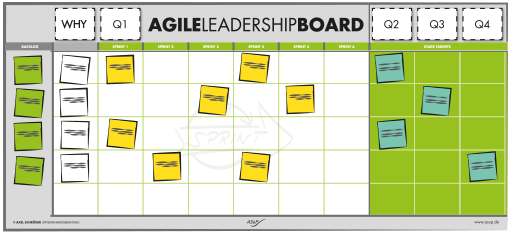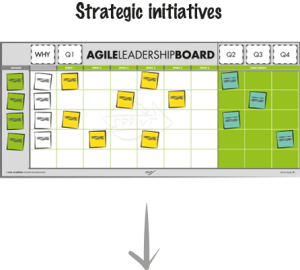
Work on the company.
 Organisational changes, such as the introduction of product lines or the bundling of resources in competence centres. However, process optimisation, the introduction of new IT systems, the introduction of methods to improve target agreements or agile transformation also aim to improve the conditions in which people work. Projects like these can be organised in the form of strategic initiatives.
Organisational changes, such as the introduction of product lines or the bundling of resources in competence centres. However, process optimisation, the introduction of new IT systems, the introduction of methods to improve target agreements or agile transformation also aim to improve the conditions in which people work. Projects like these can be organised in the form of strategic initiatives.

Less is more.
The problem with most management teams is that they have more ideas for organisational change than they have the capacity to implement. The result is often frustrating and, for long-serving employees, resigned. It is often said: “The boss was at a seminar again”, or “now the next pig is being driven through the village”. Such plans are often put in place at the turn of the year, and good intentions are not realised.
This behaviour is all too human. After the good intentions after the New Year, swimming pools have the highest visitor numbers in January and fitness clubs sign the most subscriptions in January.

Strategic initiatives as AGILE projects.
It is different if these strategic initiatives are treated like agile projects. The same principle that applies to projects at working level can also be used for the implementation of strategic initiatives. The difference is that the team members are managers and the product owner is effectively the boss. They also work in 2-week sprints with clear goals, freedom and feedback.
They have an AGILE leadership board for an overview of all strategic initiatives. This transparency shows at a glance which and how many strategic initiatives are currently running and which of them are generating progress.
The art of strategy is renunciation. Less is more. It is better to have fewer parallel projects with greater intensity, earlier successes and greater impact on results.

Leading by example.
Agile leadership teams themselves experience much more directly and intensively what it means to drive issues forward with more commitment and better self-organisation. AGILE leadership teams show their employees that they not only delegate AGILE, but also drive it forward themselves as role models. People can hear from your words that you know what you are talking about. You can better assess the challenges that employees at team level face when changing to an agile way of working. If the teams in the projects experience that their managers are also actively involved in this change themselves, the respect and commitment to commit to it grows.
